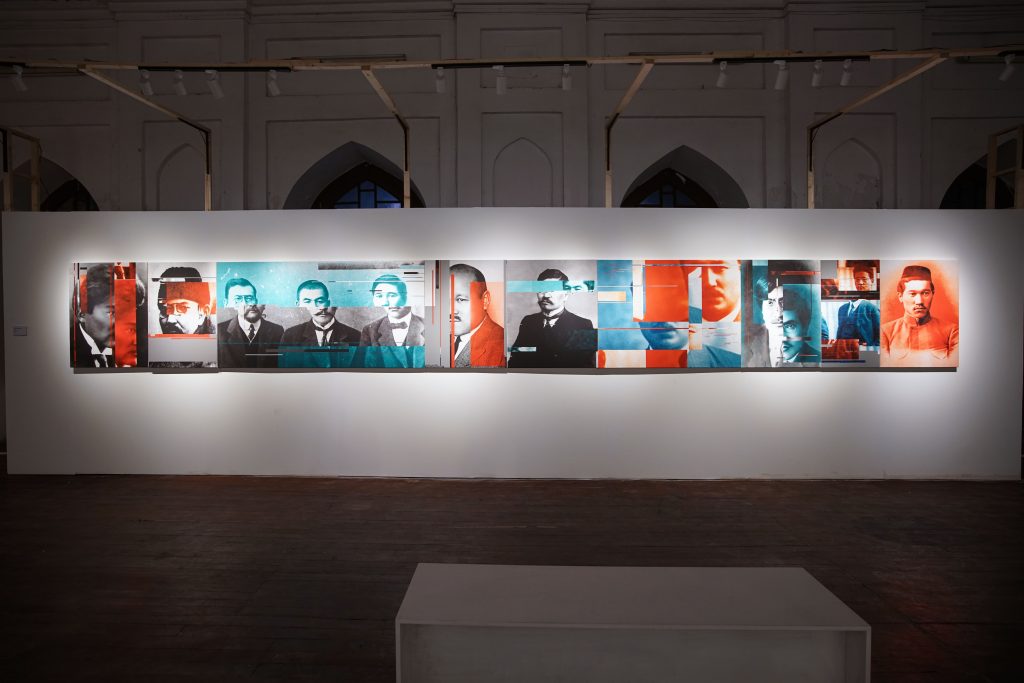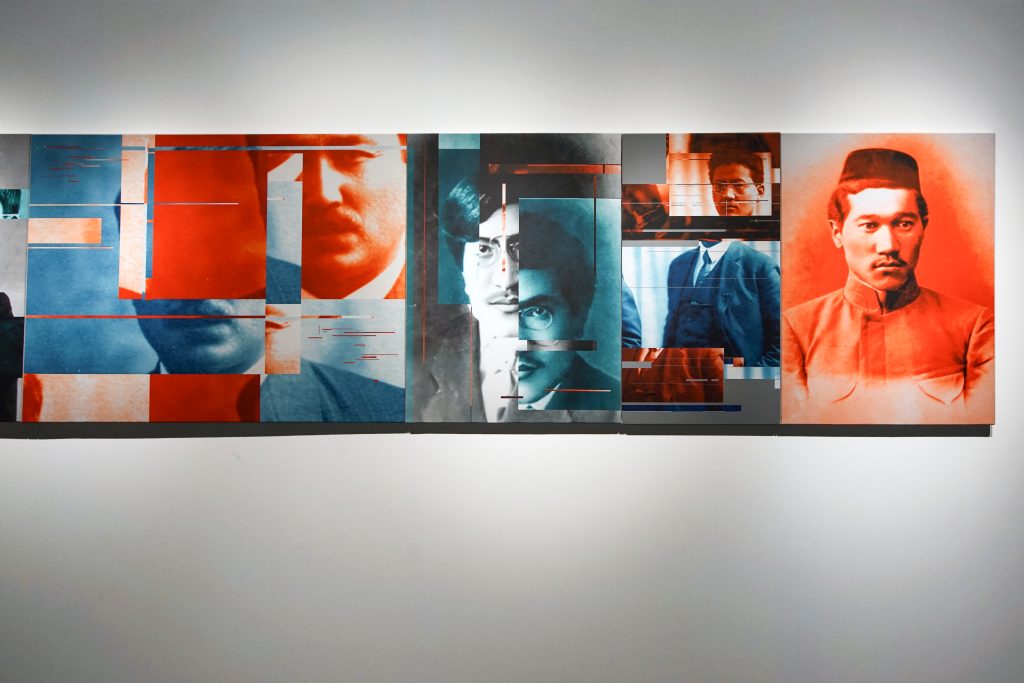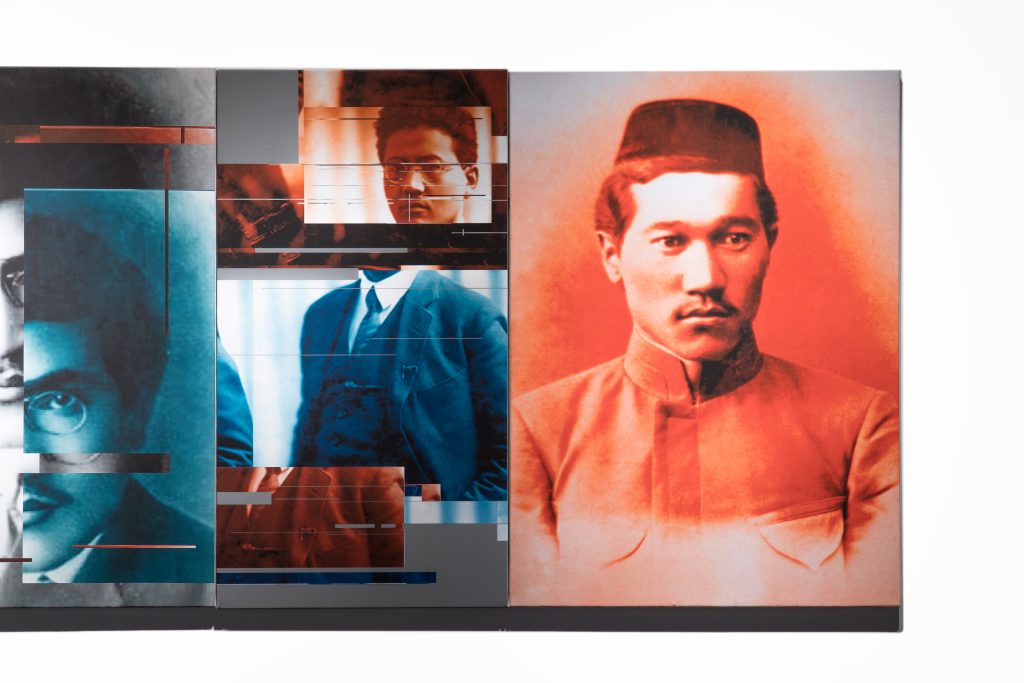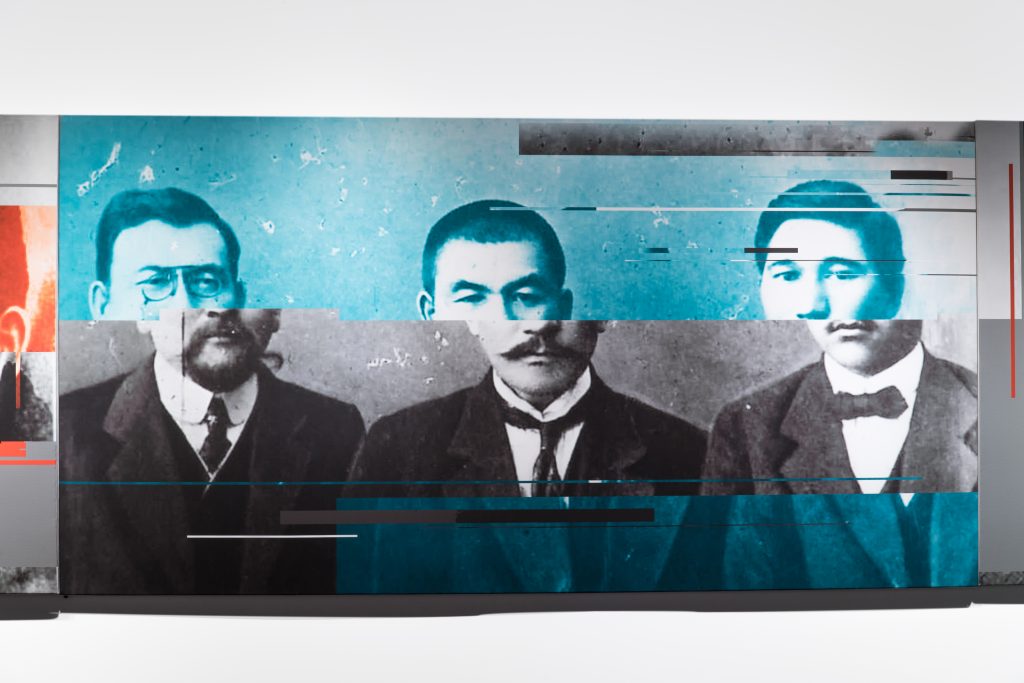Syrlybek Bekbotayev
Red Filter, 2014–18
Series of photographs
Syrlybek Bekbotayev’s “Red Filter” series focuses on one of the most tragic periods of history of Kazakhstan. The Stalinist Terror of 1930s claimed millions of lives but most importantly set into motion the ideological machinery for memory erasure. Hundreds of names of purged intellectuals were forgotten for decades and historical narratives got ‘distorted.’ This distortion and numerous ruptures of memory and history become the core of the series where Bekbotayev depicts many of the victims of the Great Terror – the first generation of Kazakh political and cultural elites of Alash party. The artist downloads portraits of these intellectuals, writers and politicians from the Internet and then deconstructs each image along the horizontal and vertical lines to demonstrate the continuous distortion. While these faces are emblematic for contemporary Kazakhstan they also symbolize the seventy years of generational and historical cultural amnesia. Little is known about the fate of these intellectuals after 1937 and most of these biographies end with the following: “perished,” “repressed,” and their burial sites remain unknown. What is left of them are their works and their portraits. Bekbotayev uses the pictorial distortion of the image as a critical reflection of the cultural amnesia and totalitarianism. The ‘red’ filter symbolizes the Communist filter of the twentieth century. Most of the portraits Bekbotayev presents are recognizable by the Kazakhstani citizens who also immediately see the ‘distortions.’ These distortions also represent different ideas to different audiences – both the Communist past but also the current political and historical attitude towards history of Kazakhstan and its most tragic periods.
سرلیبک بیکبوتیو
سرلیبک بیکبوتیو کی سرخ فلٹر سیریزقازقستان کی تاریخ کےایک المناک دور پر مبنی ُ ہے۔ 1930 کے عشرے میں اسٹالن کے ظلم و ستم سے جہاں دسیوں لاکھ لوگ مارے گئے وہیں اسی دورمیں ہی دماغوں سےتاریخ اوریاداشت مٹانےکی نظریاتی مشینری بھی چاُلوکی گئی۔ قید کیے گئے ہزاروں دانشوروں کے ناموں کو دیا گیا اور تاریخی تناظر کو مسخ کیا گیا۔ یاداشتوں اور تاریخی تناظر کا مسخ کیا جانا اوراس میں ڈالے گئے رخنے اس سلسلے کا مرکزی حوالہ بن جاتے ہیں سرلیبک اس ظلم کے کئی متاثرین کا نمائندہ دکھایا جاتا ہے۔ یہ قازقستان کی ا ش پارٹی کی سیاسی و سماجی اشرافیہ کی پہلی نسل تھی۔ آرٹسٹ ان دانشوروں، لکھاریوں اور سیاستدانوں کی تصویریں انٹرنیٹ سے حاصل کرتا ہے اوراس کے بعد ان تصویروں کی افقی اورعمودی ُرخ سے رد تشکیل کی جاتی ہے جس سے مسلسل مسخ کیے جانے کا عمل ظاہر ہوتا ہے۔ جہاں یہ چہرے جدید قازقستان کے لیےعلا متی حیثیت رکھتے ہیں وہیں یہ ستر سال کے نسلی اور تاریخی و ثقافتی نسیان کی بھی ترجمانی کرتے ہیں۔ 1937 کے بعد ان دانشوروں کے ساتھ بیتی اس کے متعلق بہت کم معلوم ہوپایا ہے اوران میں سے اکثر خود نوشتوں کا اختتام کچھ اس طرح ہوتا ہے،” مار دئیے گئے، دبا دئیے گئے” ان کی جائے تدفین ی کسی کو معلوم نہیں ۔ ان کے خاکے اور تحریروں کے سوا کچھ باقی نہ بچا۔
بیکبوتیونے تصویری ردتشکیل کواستعمال کرتے ہوئے ثقافتی نسیان اورمطلق العنانیت پر نہایت تنقیدی روشنی ڈالی ہے۔ ُسرخ ِفلٹر سے بیسویں صدی کے کمیونسٹ ِفلٹرکونمایاں کیا گیا ہے۔ بیکبوتیو کی طرف سے پیش کردہ اکثر تصویروں کو قازقستان کے باسی پہچانتے ہیں اور یہ لوگ بعد میں ان تصویروں کا مسخ ہونا ی دیکھتے ہ ۔ مسخ کیے جانے سے مختلف قسم کے سامعین کو مختلف پیغام دیا جاتا ہے۔ جہاں کمیونسٹ ماضی کا بیان پیش کیا جاتا ہے وہ قازقستان کی تاریخ کےاس انتہائی المناک دور کے متعلق معاصر تاریخی و ثقافتی رجحانات کی ی نمائندگی کی جاتی ہے۔
Text by Barbara Hyvert, Stimultania




